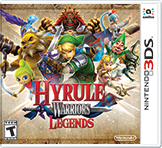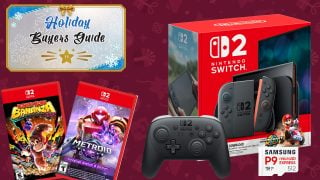Hyrule Warriors Legends serves as both an expansion and a retooling of its console-based older brother. When it was released in 2014, my friends and I frequently gathered around the Wii U and traded off turns to head through the game’s story, or Legend, mode. It was a fantastic time made only greater by our shared love of the Zelda series and Dynasty Warriors style gameplay. With the 3DS version now in my hands, some of the magic has worn away and in its place stands a host of new content and conveniences afforded by further development and the change in platform. As a whole, this version stands as a suitable alternative experience, though I feel only the most ingrained of fans would call it a must-play addition.
Important note: Before going further it needs to be said that all my time with the game was spent on the New 3DS, with its increased processing power making a world of difference. From those I’ve spoken to directly about the title’s performance on the original 3DS, 3DS XL and 2DS, it suffers from frame rate and performance issues throughout. Plagued by nearly constant slowdown, frequent pop up for enemies and other assets, the omission of 3D entirely, and just an overall lack of polish; this should have followed in Xenoblade Chronicles 3D’s footsteps as a New 3DS exclusive title. While it could be argued this puts the game in a wider audience’s hands, there’s no value in something fundamentally flawed. As such the points, observations, and score for this review will be based only on the game as it plays on New 3DS.
A legend retold
When starting up Legends’ story mode I was a little surprised, then disappointed. I was greeted by the same intro I had enjoyed on Wii U over a year ago, and the repetition just kept on coming. While there were a few subtle differences, at large the Legend Mode is identical to the Wii U’s. This wouldn’t be as exacerbated if not for the “Warriors” in the title, as Musou games are repetitious by design. As a high speed action game built on absolutely decimating hordes of weak enemies, it exists to empower the player and provide visual spectacle and a combo system that allows for flexibility and creativity once mastered. That being said, it’s still frequently a series of attacks again and again while darting across the maps to reach your next objective, with little variance. Sure there are times where instead of capturing a section of the map you’re escorting a massive Bombchu or trying to chase down a boss character, but it’s all the same from a gameplay perspective because it’s all accomplished through proverbial hack and slash.

In and of itself that isn’t enough to wear me down as a player. I’ve enjoyed games in the main line Dynasty Warriors series as well as other spinoffs. From Dragon Quest to One Piece, there’s joy to be had with these. The problem is that I already had that kind of fun on these maps before, and while replaying them with harder difficulties is enjoyable, it usually happens after leveling and upgrading characters to offset the difference. The story is by no means emotionally driven or thought-provoking, existing solely to crossover separate Zelda worlds and timelines. As a re-tread by design, I could not get invested in what Legends had to offer. Obviously this wouldn’t be an issue for anyone who either absolutely enjoyed the Wii U version or who’d never played it before, and once I pressed through the early stages and started seeing the newer content exclusive to the 3DS version I was back on board.
New warriors join the fight
The most notable of these additions are the five new characters: Tetra, King Daphnes, and Toon Link from Wind Waker, as well as Majora’s Mask’s Skull Kid, join the rest of the Zelda cast, while original character Linkle makes her debut. The Wind Waker characters bring along with them new locals, music, bosses, and a sub item and represent the largest addition to Legend Mode. Of them I enjoyed King Daphnes the most, with his role as the King of Red Lions bringing a unique moveset and style to the game. Tetra is similarly enjoyable, with her pirate stylings and cheeky demeanor helping her stand out amongst the sizable roster. As another version of Link brought into the fray, Toon Link doesn’t bring as much to the table when compared to the likes of Young Link, but still manages to bring a smile, thanks to his ever present visual charm and expressiveness.

Skull Kid is my personal favorite addition, fighting alongside Tatl and Tael while wielding dark magic and an ocarina. Unfortunately, he is not as ingrained in Legend Mode as the Wind Waker content but is a welcome addition for sure. Linkle, on the other hand, serves as a fun, infrequent side element to Legend Mode. With dual crossbows she offers unique gameplay opportunities, including a shift in camera perspective to fill the hordes of enemies with bolts based on a special meter. Less of a “female Link” and more of a self-assured girl who thinks she’s the hero of legend, with her earnest yet misguided outlook on the world and her place in it she’s a shine of optimism from both a character and gameplay perspective.
It should be noted that anyone who didn’t purchase any of the Wii U version’s DLC will also be getting their hands on the additional characters and weapons from those packs in their 3DS game as well. Link’s Spinner weapon is also included, having previously been an amiibo-based unlockable. Amiibo features are the same as the Wii U’s version, with players able to scan up to five in a given day for weapons, rupees and other rewards. For the Zelda series figures these rewards are guaranteed to be higher leveled weapons meant for their depicted characters.
Ways to adventure, anywhere
The new gameplay conveniences serve as another positive addition to the handheld version. I found the most useful and welcome of these to be the ability to switch characters on the fly with a tap of the touchscreen. With multiple characters present on missions, this allows for objectives and character specific chests to be reached more easily. Rather than rush through the map and potentially away from my current objective to defend an area about to fall, I could just change characters to take in it before switching back my original character, still relatively close to where I left them. The new ocarina item also helps to make map managing less of a headache. By activating owl statues on certain maps I was able to easily warp when needed, removing some of the tedium and backtracking missions could sometimes have on the Wii U.

It also bears mentioning that overall I’m finding myself more invested in the handheld version than I ever did on console. The portability allows me to play a mission during a break at work or otherwise away from home, feeling more digestible than committing time to a handful of missions or maps while at home. Adventure Mode in particular benefits from this, as those challenges were already more bite-sized than Legend Mode’s maps. This separate, 8-bit themed mode allows you to progress through maps based on the likes of the original Zelda’s overworld map in order to unlock new weapons, costumes, characters, and the new to Legends fairies. The My Fairy Mode allows these collected sprites to be outfitted as you like and provide unique effects, such as their trademark reviving, when in Adventure Mode. While hardly essential, My Fairy is a nice touch that adds a new layer to the mode and adds another collectable to the already content-rich title.
For what new content is added, one part of Hyrule Warriors on Wii U that’s sadly lost in the handheld conversion is multiplayer. This isn’t the only limitation brought about by the platform, as more than anything the game’s presentation suffers due to the system it’s on. For a game meant to pit you against hundreds of foes at a time, the maps are comparatively sparse with enemies randomly appearing occurring even on a New 3DS. Performance is consistent when played with the 3D effect turned off, but when on, the game noticeably slows. As such I only toggled it occasionally during cutscenes, though even then the effect was hardly noticeable. The character-specific special attacks, meant to be over the top shows of strength used to clear dozens of enemies at a time, are also lacking in spectacle, with nowhere near as much impact as they have on Wii U.

In spite of everything that might have come across as unfavorable opinions, I’ve been having fun with Hyrule Warriors Legends. It’s a spectacular piece of Zelda fan service that will only be growing with future DLC additions. I recommend this most highly to anyone who hasn’t played the Wii U version before and enjoys a hack and slash with plenty to unlock and develop. Even for those who have seen everything the Wii U game had to offer, if you were able to devote that much time then playing through again to experience the new content may be the excuse you’ve needed to have at it again. No matter what, just be prepared for repetition by design. If not for the hardware limitations, based on content and gameplay I’d go so far as to call Legends the definitive edition of Hyrule Warriors. As it stands, it’s a fine handheld Warriors game for Zelda devotees, all at once a remake, alternative, and companion to its console predecessor.
Leave a Comment
System: Nintendo 3DS
Release date: Mar 25, 2016
Publisher: Nintendo
Developers: Koei Tecmo, Team Ninja, Omega Force


